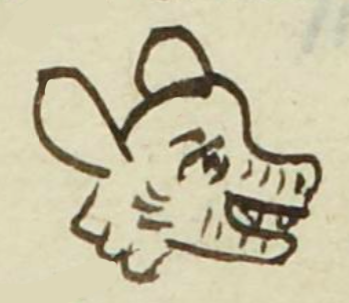Huehuecoyotl (MH777v)
This black-line drawing of the simplex glyph for the personal name Huehuecoyotl ("Old Coyote") is attested here as a man's name. It shows a coyotl (Nahuatl for coyote, which comes to English from Spanish) with a wrinkled face (suggesting "elder," huehue-). The coyote is shown as a head only, in profile view, looking toward the viewer's right. His visible eye is open, as is his mouth. His teeth are visible, and his ears are leaning back somewhat.
Stephanie Wood
Huēhuecoyōtl appears in the Codex Borgia and in the Vaticanus B codex, according to Elizabeth Hill Boone. She also notes that the coyote had a "habit of threatening people along the road" and a "proclivity to sow discord and cause ruin. She adds that in the Borgia image he holds a string of jewels that associate him with "the lords of pleasure." The Vaticanus B image relates to his being "a liar and a deceiver." (See her Cycles of Time and Meaning in the Mexican Books of Fate (2013).) In Sam Egerton's Theaters of Conversion (2001), Huehuecoyotl is said to be associated with "sportive pleasures, mischief, and eroticism...," and in an article by Gabrielle Vail and Allen Chistenson [in Birds and Beasts of Ancient Mesoamerica, eds. Susan Milbrath, Elizabeth Baquedano (2023, 284)], he is referred to as "hypersexual."
Stephanie Wood
melchior . vevecoyotl
Melchor Huehuecoyotl
Stephanie Wood
1560
Jeff Haskett-Wood
coyotes, animales, viejos, nombres de hombres, música, sexo, travieso, arrugados

huehue-, old, https://nahuatl.wired-humanities.org/content/huehue
coyo(tl), coyote, https://nahuatl.wired-humanities.org/content/coyotl
Coyote Viejo
Stephanie Wood
Matrícula de Huexotzinco, folio 777v, World Digital Library, https://www.loc.gov/resource/gdcwdl.wdl_15282/?sp=629&st=image
This manuscript is hosted by the Library of Congress and the World Digital Library; used here with the Creative Commons, “Attribution-NonCommercial-ShareAlike 3.0 License” (CC-BY-NC-SAq 3.0).




